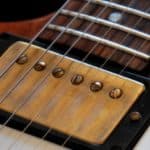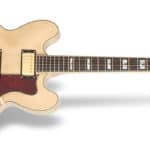Not all electric guitars are built the same. In fact, there are at least 4 or 5 great categories under which most of the electric kind could be classified.
When choosing a new guitar, getting to know the nuances between these different body construction types will give you more tools to make a better decision.
But do different types of electric guitar bodies affect the tone? Here is a short answer:
Electric guitar body types have a big impact on tone. Solid bodies sound brighter, have more sustain, and are less prone to feedback. Semi-hollows have a center block that helps with feedback, sound warm, resonant, and have less sustain. Hollow bodies have great bass and resonance, but feedback is a problem.
For those who want a deeper dive into the differences between guitar body types, in this article, I will talk firstly about their impact on tone, and then I will define briefly the most common categories there are.
After that, I will answer a few very common questions many players have.
Finally, I will give you my conclusions and recommendations about what I think might be better for you if you are interested in getting a new instrument.
Are you ready to get started?
Let’s go!
How do electric guitar body types affect tone?
Electric guitar body types have a deep impact on the instrument’s final tone. The way they are constructed will have an influence on how the instrument resonates and which frequencies it enhances or dampens. Different kinds of construction types each have their own personality in terms of tone.
For instance, solid-body guitars will sound brighter than hollow-body ones and will be less prone to feedback.
The rule of thumb is the more hollow, the warmer the tone gets, and the more acoustic-like the sound becomes.
How much does an electric guitar body type affect its tone?
Quantifying how much a certain aspect of a guitar influences its tone is no easy task. It would require extensive scientific research to arrive at conclusive results.
What I can offer you is empirical evidence, based on the opinion of many players.
Construction type for the body has a deep effect on a guitar’s sound and its use cases.
Although I always claim that the neck of a guitar has a bigger impact than its body, in terms of tone, it’s also true that a semi-hollow body guitar sounds nothing like a solid-body one.
Resonance chambers really change the character of the instrument. They make it sound warmer and louder acoustically.
However, this added resonance near the pickups makes them more sensitive to feedback, which is a big drawback for those players that enjoy playing with some distortion.
Most common guitar body types and their effects on tone and playability
There are 3 big categories for guitar body types, however, you can open up the solid-body taxonomy into pure solid bodies, chambered bodies, and weight relieved bodies.
Let’s take a deeper look into each guitar body type:
Solid-body

Solid-body guitars are the most common kind of electric guitar nowadays. It was not always like this.
Les Paul is recognized for inventing the solid-body electric guitar in the ‘40s, and Leo Fender was the one to start marketing them to a broader audience in the ‘50s.
Before this, all guitars were hollow.
Solid-body electric guitars sound brighter, have more sustain, and take way much more distortion than any other kind before even worrying about feedback.
There is a broad variety of sounds available among this kind of instrument, and it would be dumb to try to attach them to any particular EQ or tonal profile.
In terms of volume, these are the quietest of them all when playing unplugged, but well, they are not designed to work without an amp anyways.
Another cool feature of solid bodies is that they can be shaped in any form without compromising acoustics. This also makes them cheaper and easier to manufacture.
Chambered
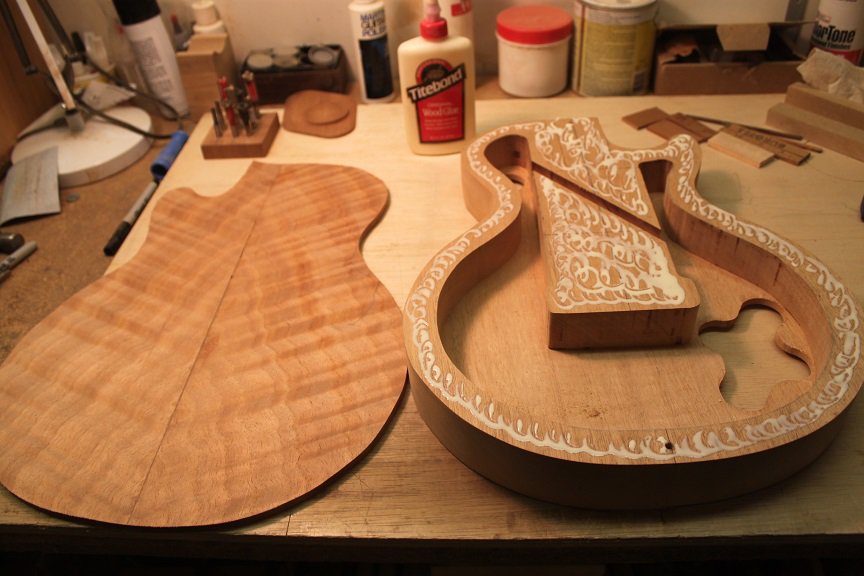
Chambered guitars are kind of a subspecies of solid body ones, but actually have a lot to do with semi-hollow bodies.
This kind of construction was mainly popularized by Gibson with their chambered Les Pauls, an attempt to make their iconic guitar lighter, especially in times when they couldn’t reliably get lighter mahogany for their necks and bodies.
The chambers on these instruments take up a great part of the body, however, they are not exposed by any kind of f-hole. In terms of aesthetics both a chambered and a completely solid Les Paul look exactly the same.
Of course, the added resonance of the chamber is a side effect to its effective weight reduction, and this makes the guitar sound noticeably more like a semi-hollow one, and suffer from the same feedback problem when playing at high volumes.
Weight relieved
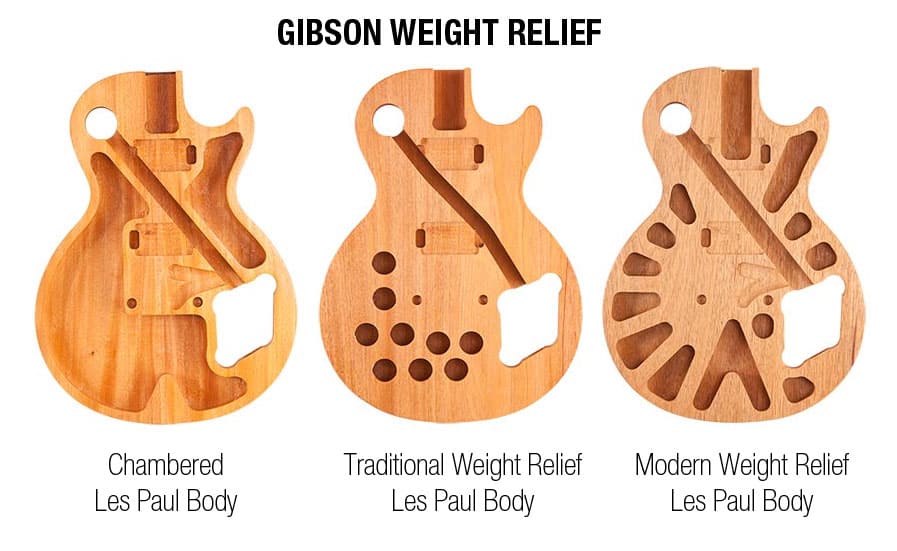
Weight relieved bodies are another alternative popularized by Gibson, but less drastic than the chambered solution.
On their first iterations, the weight relief just meant poking holes into the body, before gluing the top, and without getting through the back.
This effectively reduced the instrument’s mass, resulting in reduced weight with no added unwanted resonance.
More modern iterations improved the design of the weight relief making it less impactful on sound, however, many players claim it’s still noticeable.
In practical terms, weight relieved instruments have the same feel and almost the same sound as solid-body ones.
The tonal difference is that these guitars have a bit more present mids and a slightly punchier top end.
Semi-hollow
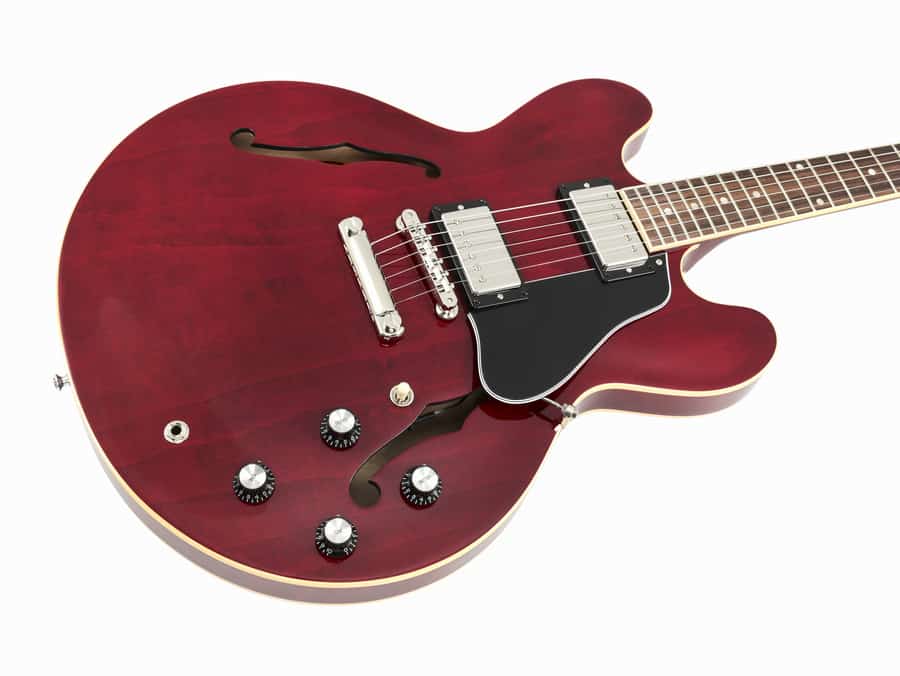
Semi-hollow guitar bodies are a classic and the weapon of choice of many blues and rock players.
These are pretty much like hollow-body guitars, however, they have a center block, usually made from some type of hardwood, into which most of their hardware is mounted.
This solution helps to combat feedback issues, however, it’s not infallible. Semi-hollow guitars are way more sensitive to it when playing loud than their solid-body cousins.
In terms of tone, these ones sound warmer and are extremely resonant. They have a surprising acoustic volume, again compared to solid bodies. However, sustain is not a strong point.
Semi-hollows are lighter, however, in many cases, bulkier.
Hollow

Hollow body guitars are just the historic origin of the instrument. Think of them as acoustic guitars that evolved into the electric world in the early 1900s.
This doesn’t mean that they are extinct. Have you ever seen a jazz player? They love this kind of guitar, also called archtops.
They are at the extreme of sensitivity to feedback, and this is why you will mostly hear them be played through a clean amp.
But this is hardly a drawback. They sound gorgeously warm and have a very tight low end.
Hollow bodies sound almost acoustic guitars when played unplugged, and that’s because they pretty much are ones. The only difference is that they don’t have a big hole in the middle to project the sound, but they usually have smaller f-holes on the side of the body.
Solid-body vs semi-hollow body
The main difference between solid body guitars and semi-hollow body guitars, apart from construction, is how they sound. Solid bodies have a brighter tone and a big tolerance to amplified volume before feedback. Semi-hollows sound warmer, are more resonant but are more prone to feedback problems.
Hollow body vs semi-hollow body
The main difference between hollow body and semi-hollow body guitars is the center block these last ones incorporate. This is a big piece of hardwood that runs through the middle of their bodies to which most hardware is attached helping reduce feedback when played overdriven or even distorted.
Which guitar body type is better?
There is no guitar body type better than any other, and it will depend on your playstyle and the kind of sound you are after. Solid-body guitars are great for modern distorted tones, semi-hollows work great for overdriven rhythm and lead, while hollow bodies shine on clean tones with deep bass.
Conclusions and recommendations
Whether you are looking for a new guitar or planning on building or having one built, getting to know, at least at a high level how different body types are built and sound is, in my opinion, something that will help you make a better informed final decision.
However, here in GearAficionado, I always say that you should try out every instrument before buying it if you have the chance.
I don’t think anyone can really understand the sound of all these different body types without getting to hear them live. At least the ones that you think might work out better for you.
If it’s within your reach, try to get to play completely different guitars to clearly understand where the variation lies, and then start checking out ones closer to the one you preferred the most.
Finally, don’t forget to have fun. Technicalities for some people get the joy out of getting a new piece of gear. You don’t have to know it all about something that makes you smile. Just go and play the instrument that feels best to you.

Hello there, my name is Ramiro and I’ve been playing guitar for almost 20 years. I’m obsessed with everything gear-related and I thought it might be worth sharing it. From guitars, pedals, amps, and synths to studio gear and production tips, I hope you find what I post here useful, and I’ll try my best to keep it entertaining also.




